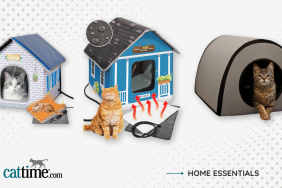According to the ASPCA, 3.4 million pet or companion cats enter shelters every year. Only about 100,000 of those cats will be reunited with their humans. Sadly, 1.4 million of those cats will never leave the shelters, being “humanely euthanized.” Don’t let your cat become one of these sad statistics.
It’s one of the most traumatic experiences for both cats and their humans when a cat is lost or escapes. That is why it’s so important to make sure your cat has a microchip. It will help increase the odds that your cat will come back to you.
Cats are very good at hiding, so first you need to make sure your cat is not hiding or trapped somewhere in your home. Open every closed door and closet. Look behind and under every piece of furniture. Open every cupboard and check any boxes that may have been out. Cats can hide in a box and you might close the box and put it away and not even realize. Use food and toys and sounds that will coax your cat out of hiding.
Take action and look everywhere
If your cat is lost and you can’t find him or her, you need to take action immediately.
Contact the local animal shelter and animal control agencies as soon as you realize your cat is missing. File a lost pet report with every shelter within at least a 60-mile radius. You might be surprised at how far a cat can travel. Most shelters will take a lost pet report over the phone, and it’s helpful if you can email them a color photo of your fur baby. Be sure that you give them an accurate description. If you believe that your cat was stolen, file a police report. Whenever possible, go to the shelter yourself or send a reliable friend. Visit daily to look at all the cats, including cats that may be in the “back room” where sick and injured animals are kept away from the general population. Most shelters are reliable, but it’s safer to see for yourself if your cat is missing.
Use the internet to widen your search. There are sites that may be able to help you out, including the Center for Lost Pets, Fido Finder, Lost Pets USA, Craig’s List, and Pet Amber Alert.

Search the neighborhood
Walk or drive through daily, and ask every neighbor, letter carrier, and delivery person if they have seen your cat. Show them a color photo and give them your phone number in the event they see your cat later. Hand out pictures of your cat with your contact information to everyone, so they know what to look for and how to get in touch with you. Make dozens of index cards with this information and a description of your cat, and leave a card at houses and on car windshields if you are unable to talk directly with homeowners in your area.
As you drive and walk your neighborhood, call your cat by name. Bring a can of food. Bring their favorite toy. Enlist family and friends to do the same, so you can canvas the area thoroughly and frequently.
Make posters for your lost cat
Make posters – lots of them – and keep it simple and informative. “LOST CAT” in bold letters that can be easily read from a distance is the headline. Below that, include a basic description but keep some details private. You can offer a reward, but don’t state how much in the ad. Be sure to include your phone number and email address. Post these notices at traffic intersections, grocery stores, community centers, veterinary offices, and other locations. Get the word out, because the more people who know your pet is lost and you are searching, the more likely it is that someone will spot your cat and contact you.
Place a lost pet ad
Some local radio and television stations have “lost pet” alerts, if not on-air then frequently on their own websites. Ask if you can post the information on your cat so anyone who sees your cat can contact you. A frightened animal can cover a lot of ground and may end up far from home, so it’s critical to broaden your search. Place an ad in the local newspaper.
Make a list of all of the places you’ve posted notices so they can be removed when you recover your pet to avoid having people continue to search for a cat that is safely back home!
Contact everyone you can
Contact all veterinary clinics in your area and any emergency vet clinics. Sometimes people pick up a stray cat and may drive the cat some distance to a clinic. Email these clinics a photo and description of your cat and ask that they post a lost cat notice.
Email everyone on your own contact list, sending them the description and a photo. Encourage those who can to help you search. Create a Facebook page and post photos daily asking your friends and family to share these photos on social media to get the word out to even more people. Ask everyone to share the information on their Facebook walls. Use Facebook to contact local rescue groups in your area and ask them to also share your cat’s photo on their wall. They are networked with vast amounts of animal rescue workers in your area who will see the photo and have contact with many homeless cats through their rescue work.
Warning on pet recovery scams
Be wary of pet-recovery scams. If you’re contacted by a stranger claiming to have your cat, ask them to describe your cat thoroughly before giving out any information. This is the reason you don’t want to put too much detail on your flier. Keep some details private to use for confirmation if contacted by someone on the phone or internet. Be sure that they can identify characteristics you left out of your advertisement. This will assist you in determining if they’re trying to scam you or actually have your cat. Ask them to text or email you a photo of your cat for confirmation.
Be especially careful if they insist on payment for the return of your pet or come up with excuses to delay the return of your cat. Call the police if you suspect a scam. They could be running a scam where they actually kidnap cats and hold them for ransom. You will need to get the police involved immediately because these people are professionals at using your emotions to take your money and you may never see your pet again.
Other scams targeting lost cat owners
Also, it’s common for pet psychics or people claiming to be pet psychics to contact you and say they know where your pet is. They often have a message of “your pet is alive and well but you may never see them again.” This may be a misguided effort to make the parent of a lost pet feel better, but do not give them money either. You can thank them for the message and move on.
Don’t give up hope
Don’t give up! Try everything and look everywhere. Many animals have been lost for months or years before being found and reunited with their families. Usually, microchip identification considerably helps with this.
If you have lost your cat, we are so sorry to hear that. Some of us at CatTime have been through this before with varying results. Our hearts go out to anyone who has lost a pet. It’s truly the worst feeling in the world. Be strong. Do not blame yourself. Keep hope alive.









